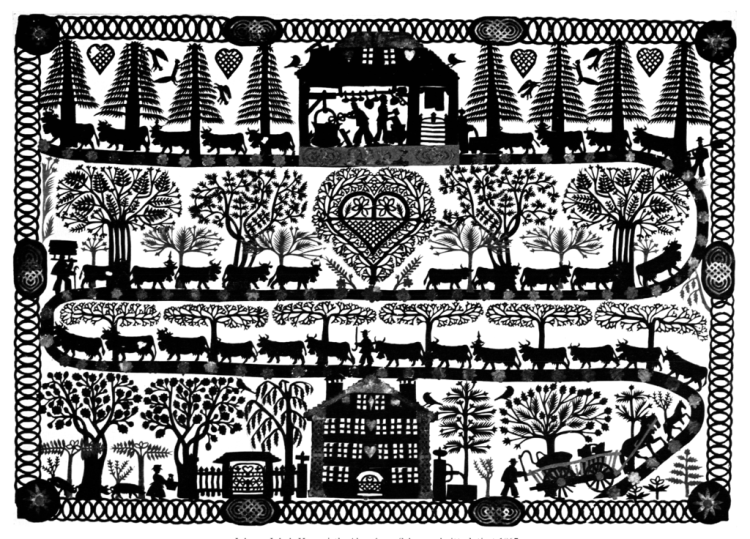It has been at least twenty-five years since I discovered a Swiss art-form called paper-cutting or Scherenschnitte. And now I’ve discovered a new Swiss paper-cutter, Marc Schweizer, who’s about to have a show of his work in the Alps.
Although the Chinese had already been making paper-cuts for at least 1500 years, the craft didn’t become well-known in Europe until the eighteenth century, when portrait silhouettes grew popular. The traditional Swiss style of paper-cutting came along later still. It dates back to one man, Johann Jakob Hauswirth (1809-1871) and, through him, to one region, the Saanenland, a series of Alpine villages in the Saanen River valley where the cantons of Bern, Fribourg, and Vaud meet.

Hauswirth was a day-laborer who went from place to place on the Alpine border between Bern and Vaud, looking for work on mountain farms. Using whatever scraps he could find, including bits of wallpaper and candy wrappers, he cut paper into local scenes and gave his creations as gifts to people who fed and housed him. After Hauswirth’s death, his paper-cutting style was taken up first by a Rougemont postman, Louis Saugy, and then by other regional men and women, until it became a popular pastime in the Saanen area. Today, you can see examples of paper-cuts by Hauswirth, Saugy, and artists up to the present day at a museum in the small town of Chateau d’Oex on the Bern/Vaud border.
One of the most popular subjects in traditional Swiss paper-cutting is the Alpaufzug, the spring parade of local cattle from the lowland pastures up into the mountains, where they’ll spend the summer eating Alpine grass. Many of today’s paper-cutters, however, work with more modern themes, carving out a balance for themselves between the old and the new.

One of these new artists is Marc Schweizer, a 35-year-old structural draftsman-turned-architect who was born in the Bernese Alps less than ten miles from Hauswirth’s hometown of Saanen. Schweizer began by making his own versions of traditional subjects—cows and goats under trees, old-fashioned farmhouses, bouquets of flowers—but soon his artwork grew more individual in style and subject-matter. One of his inspirations was an extended trip to the United States in 2016, when he walked the Appalachian Trail from Georgia to Maine and met the woman he’d marry two years later. A number of his ideas for later paper-cuts came from that long, long walk in the woods.
Schweizer has shown his work several times, but I only just found out about him from an invitation to his upcoming exhibition, which will run from January 23 until April 24 in Hüsy, a restaurant-and-gallery in the village of Blankenburg, which is also in the Saanen region. Hans-Jürgen Glatz, the owner of the place, is himself a paper-cutter as well as a cook and a collector of old and new examples of Scherenschnitte.
I know that most of you, dear readers, are far away from the Bernese Alps and won’t be able to attend Marc Schweizer’s show. But he has a website, www.schweizerpapierschnitt.ch, where you can admire more of his pictures and even get in touch with him if you like.
I have a few small Swiss and Chinese paper-cuts on the walls of my office. Do any of you own any, and, if so, from which countries?


I love this article and am such a big fan of découpage as it’s called on my side of the Alps. As much as I adore the black and white motifs, I also love the work of Anne Rosat, who used coloured papers and was part of the revival of this almost lost art. She’s so famous, that Hermès asked her to design one of their iconic silk scarves. Whenever I see one of these beautiful alpine scenes, I’m immediately reminded of home and Swiss traditions. Thank you for this article and for leading me to discover the work of Marc Schweitzer. Wonderful
LikeLiked by 1 person
So glad you like the article, Melina, and thanks for mentioning Anne Rosat, whose work I also like a lot. I didn’t know about her Hermès scarf–that’s a great story.
LikeLike
I love this work, also. I have a pretty wonderful modern Chinese paper cutting that Ariel gave me a number of years ago. Since cutting is one of the things that this left-handed person is very bad at, I find this art particularly impressive!
LikeLike
I know how hard it is for lefties to cut with a right-handed scissors! I believe quite a lot of this work is done with very sharp little knives as well; I will have to find out more about the technique.
LikeLike
He is fabulous, he is one of the best, the exhibition at Hüsy is absolutely worth seeing!!!
LikeLike
I’m so glad to hear that. I can’t wait to see his work there. Thanks for writing.
LikeLike